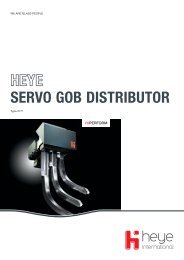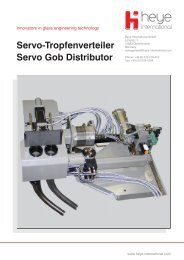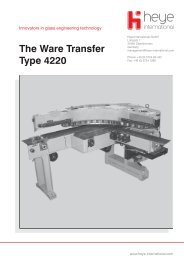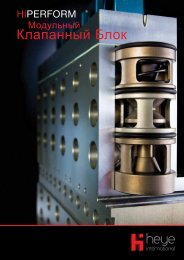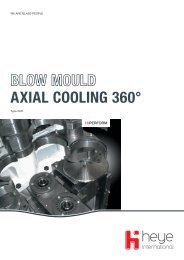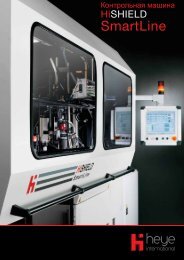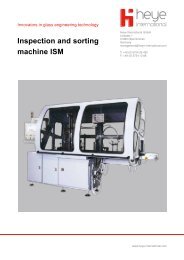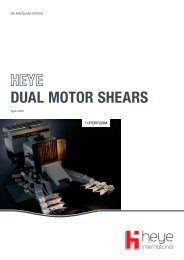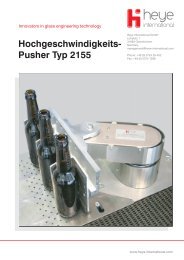Press Duration Control - Heye International
Press Duration Control - Heye International
Press Duration Control - Heye International
You also want an ePaper? Increase the reach of your titles
YUMPU automatically turns print PDFs into web optimized ePapers that Google loves.
Automatic<br />
<strong>Press</strong> <strong>Duration</strong> <strong>Control</strong>
Reproducible Quality<br />
Until now, the <strong>Heye</strong> Process <strong>Control</strong> used plunger position sensors to adjust the plunger position in relation<br />
to the neck ring tool. This prevented incomplete or overpressed finishes.<br />
A new feature now is to control the time!<br />
<strong>Control</strong>led press duration<br />
For the first time ever, with the Automatic <strong>Press</strong><br />
<strong>Duration</strong> <strong>Control</strong> of <strong>Heye</strong> <strong>International</strong> it is now<br />
possible to control the single phases of the<br />
pressing process. // The patented procedure<br />
allows to record how long the plunger is dwelling<br />
in the glass and then controls the pressure and<br />
the time. <strong>Control</strong> of the press duration, i.e. the<br />
time the plunger is dwelling in the glass, ensures<br />
reproducible wall thicknesses. // In the hollow<br />
glass production this is a decisive quality feature.<br />
If the press duration is too short, too much glass<br />
flows to the base after delivery of the parison to the<br />
blow mould. The result is a thin neck and a thick<br />
base. // If the press duration is too long, the outer<br />
surface of the parsion gets too cold. The parison<br />
cannot reheat sufficiently in the blow mould, too<br />
much glass in the neck and shoulder area and a<br />
thin base are inevitable. If the outer surface is too<br />
cold, in extreme cases, it can even burst open<br />
when the glass container is finally blown.<br />
With the new Automatic <strong>Press</strong> <strong>Duration</strong> <strong>Control</strong><br />
from <strong>Heye</strong> <strong>International</strong> these article defects<br />
belong to the past!<br />
<strong>Control</strong> principle<br />
The piston surface of the plunger cylinder is<br />
pressurised with compressed air via a pro-<br />
portional valve:<br />
�During the plunger motion time (t1 to t2)<br />
with a controlled pressure (P1).<br />
During the press duration (t2 to t3) with a<br />
constant pressure (P2).<br />
After each pressing process the difference between<br />
the press duration set-point value and the press<br />
duration actual value is determined.<br />
If the set-point and the actual value deviate, the<br />
controlled pressure (P1) is either increased or<br />
decreased a little. This control principle causes<br />
that the press duration actual value approaches<br />
the set-point value step by step. By controlling the<br />
pressure (P1) different motion times of the plungers<br />
- from their loading position to the beginning of<br />
the pressing process - are basically compensated.<br />
Mostly constant press durations of all plungers<br />
within the machine are achieved. // The constant<br />
pressure stage (P2) determines the force which is<br />
used to press the parison against the blank mould<br />
profile during the press duration. // To cushion the<br />
plunger downward movement a pressure stage<br />
(P3) can be set.
0<br />
0<br />
0<br />
<strong>Press</strong>ure P1<br />
Plunger position<br />
End of the<br />
pressing<br />
position<br />
Beginning of<br />
the pressing<br />
position<br />
Loading position<br />
Reversal<br />
position<br />
0<br />
Signal “Plunger up“<br />
from the IS-<strong>Control</strong><br />
P2<br />
0 t1 t2 t3 t4 t5<br />
P3<br />
Motion time <strong>Press</strong> duration Cushioning duration<br />
t<br />
t<br />
t<br />
A constant dwell time of the<br />
plunger in the glass ensures a<br />
reproducible wall thickness and<br />
therefore high quality.
Optimal Usability<br />
The Automatic <strong>Press</strong> <strong>Duration</strong> <strong>Control</strong> is an optional<br />
component of the <strong>Heye</strong> Process <strong>Control</strong>.<br />
A job database enables fast and<br />
comfortable job changes<br />
All pressure and time values can be preset<br />
on the monitor<br />
�A bar graph of the pressure stages shows<br />
possible differences between individual<br />
cavities<br />
�Limit value exceedings are displayed in<br />
plain text<br />
�A pressure sensor in the proportional valve<br />
shows the pressure course as line diagram<br />
above the time<br />
Extensive diagnostic tools are included in<br />
the delivery<br />
Retrofit<br />
The Automatic <strong>Press</strong> <strong>Duration</strong> <strong>Control</strong> can be<br />
integrated in existing IS Machines (even those of<br />
other manufacturers).<br />
<strong>Heye</strong> <strong>International</strong> GmbH<br />
Lohplatz 1<br />
31683 Obernkirchen<br />
Germany<br />
Tel.: +49 5724 26-452<br />
Fax: +49 5724 1288<br />
www.heye-international.com



